教程:生成条形图
- 版本 :2023.1(当前版本)
教程:生成条形图
本教程介绍如何开发一个以简单条形图的形式显示数据的 Power BI 视觉对象。 此视觉对象支持最小量的自定义。 本文档的其他页面介绍了如何添加进一步自定义,如上下文菜单、工具提示等。
在本教程中,你将了解:
定义视觉对象的功能
了解用于生成视觉对象的源代码
呈现视觉对象
将对象添加到“属性”窗格中
打包视觉对象
设置环境
在开始开发 Power BI 视觉对象之前,请验证本部分中是否已列出所有内容。
Power BI Pro 或 Premium Per User (PPU) 帐户 。 如果没有订阅密钥,可以注册免费试用版。
Visual Studio Code (VS Code)。 VS Code 是用于开发 JavaScript 和 TypeScript 应用程序的理想集成开发环境 (IDE)。
Windows PowerShell 版本 4 或更高版本(适用于 Windows)。 或终端(适用于 OSX)。
准备好开发 Power BI 视觉对象的环境。 设置用于开发 Power BI 视觉对象的环境。
本教程使用“美国销售额分析”报表。 你可以下载此报表并将其上传到 Power BI 服务,或使用自己的报表。 如果需要有关 Power BI 服务和上传文件的详细信息,请参阅开始在 Power BI 服务中创建教程。
备注
如果未在安装过程中安装 D3 JavaScript 库,请立即安装。 从 PowerShell 运行 npm i d3@latest --save
创建条形图视觉对象涉及以下步骤:
创建新项目
定义 capabilities 文件 -
capabilities.json创建视觉对象 API
打包视觉对象 - pbiviz.json
创建新项目
本教程的目的是帮助你了解视觉对象的架构方式和编写方式。 可按照这些说明从头开始创建一个条码视觉对象,或者可克隆源代码存储库,并使用它来继续进行操作,而无需创建自己的视觉对象。
创建新的视觉对象
克隆源代码
打开 PowerShell 并导航到要在其中创建项目的文件夹。 输入以下命令: PowerShell 现在,你应该有一个名为 BarChart 的文件夹,其中包含视觉对象的文件。 在 VS Code 中,打开 [tsconfig.json](visual-project-structure.md#tsconfigjson) 文件,将“files”的名称更改为“src/barChart.ts”。 TypeScript复制 tsconfig.json 的“files”对象指向视觉对象的主类所在的文件。 最终的 tsconfig.js文件应如此所示。 package.json 文件包含一系列项目依赖项。 将 project.json 文件替换为此文件。pbiviz new BarChart"files": ["src/barChart.ts"]
现在,你应该有一个包含以下文件和文件夹的新视觉对象文件夹:
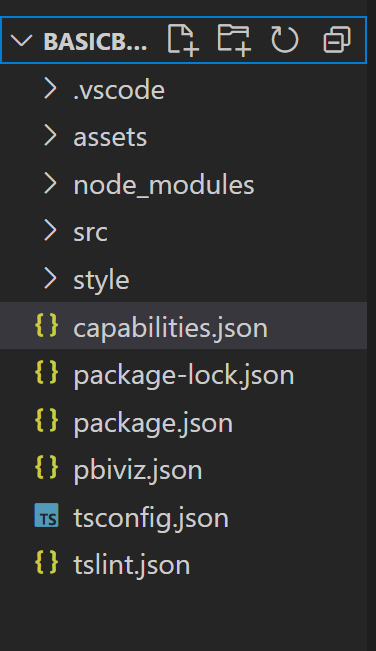
有关其中每个文件的功能的详细说明,请参阅 Power BI 视觉对象项目结构。
本教程将重点介绍的两个文件是 capabilities.json 文件和 src/barchart.ts 文件(前者描述了主机的视觉对象,后者包含视觉对象的 API) 。
定义功能
capabilities.json 文件是将数据绑定到主机的位置。 我们将介绍它接受的数据字段类型,以及视觉对象应该具有的功能。
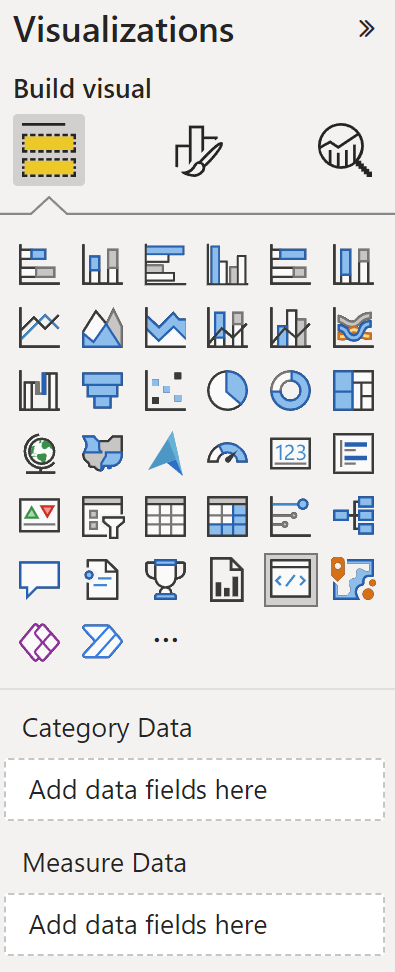
定义数据角色
变量在 capabilities 文件的 dataRoles 部分中定义和绑定。 我们希望条形图接受两种类型的变量:
分类数据,由图上不同的条表示
数值或测量数据,由每个条的高度表示
在 Visual Studio Code 中的 capabilities.json 文件中,确认以下 JSON 片段出现在标记为“dataRoles”的对象中。
JSON
"dataRoles": [
{ "displayName": "Category Data", "name": "category", "kind": "Grouping"
},
{ "displayName": "Measure Data", "name": "measure", "kind": "Measure"
}
],
映射数据
接下来,添加数据映射,告知主机如何处理这些变量:
将“dataViewMappings”对象的内容替换为以下代码:
JSON
"dataViewMappings": [
{ "conditions": [
{ "category": { "max": 1
}, "measure": { "max": 1
}
}
], "categorical": { "categories": {
"for": { "in": "category"
}
}, "values": { "select": [
{ "bind": {
"to": "measure"
}
}
]
}
}
}
],
上述代码创建了每个数据角色对象一次只能保存一个字段的“条件”。 注意,我们使用数据角色的内部 name 引用每个字段。
它还设置分类数据映射,使每个字段映射到正确的变量。
定义“属性”窗格的对象
capabilities 文件的“objects”部分是定义应该出现在“格式”窗格上的可定制功能的位置。 这些功能不会影响图的内容,但可以更改其观感。
有关对象及其工作方法详细信息,请参阅对象。
以下对象是可选对象。 如果要完成本教程的可选部分以添加颜色和呈现 X 轴,请添加它们。
将“objects”部分的内容替换为以下代码:
JSON
"objects": { "enableAxis": { "properties": {
"show": { "type": {
"bool": true
}
}, "fill": {
"type": {
"fill": {
"solid": {
"color": true
}
}
}
}
}
}
},
保存“capabilities.json”文件。
最终的 capabilities 文件应该类似于此示例中的文件。
视觉对象 API
所有视觉对象都以实现 IVisual 接口的类开头。 src/visual.ts 文件是包含该类的默认文件。
在本教程中,我们将 IVisual 文件称为“barChart.ts”。 下载该文件并将其保存到 /src 文件夹(如果尚未这样做)。 本部分将详细介绍此文件,并描述其各个部分。
导入
文件的第一个部分导入了该视觉对象所需的模块。 请注意,除了 Power BI 视觉对象模块之外,我们还导入了 d3 库。
以下模块将导入到 barChart.ts 文件:
TypeScript复制
import {
scaleBand, scaleLinear
} from "d3-scale";import {
select as d3Select
} from "d3-selection";import "./../style/visual.less";
import { axisBottom } from "d3-axis";import powerbiVisualsApi from "powerbi-visuals-api";
import "regenerator-runtime/runtime";import powerbi = powerbiVisualsApi;type Selection = d3.Selectionany, T1, any, T2>;
import DataViewCategoryColumn = powerbi.DataViewCategoryColumn;
import DataViewObjects = powerbi.DataViewObjects;import Fill = powerbi.Fill;
import ISandboxExtendedColorPalette = powerbi.extensibility.ISandboxExtendedColorPalette;
import ISelectionId = powerbi.visuals.ISelectionId;import IVisual = powerbi.extensibility.IVisual;
import IVisualHost = powerbi.extensibility.visual.IVisualHost;
import PrimitiveValue = powerbi.PrimitiveValue;
import VisualUpdateOptions = powerbi.extensibility.visual.VisualUpdateOptions;
import VisualConstructorOptions = powerbi.extensibility.visual.VisualConstructorOptions;
import { textMeasurementService } from "powerbi-visuals-utils-formattingutils";
import { dataViewWildcard } from "powerbi-visuals-utils-dataviewutils";
import { getCategoricalObjectValue, getValue } from "./objectEnumerationUtility";
界面
接下来,定义 viewmodel 接口。 以下三个接口用于描述条形图视觉对象:
BarChartDataPoint
BarChartViewModel
BarChartSettings
这些接口定义如下:
TypeScript复制
/**
* Interface for BarCharts viewmodel.
*
* @interface
* @property {BarChartDataPoint[]} dataPoints - Set of data points the visual will render.
* @property {number} dataMax - Maximum data value in the set of data points.
*/interface BarChartViewModel {
dataPoints: BarChartDataPoint[];
dataMax: number;
settings: BarChartSettings;
}/**
* Interface for BarChart data points.
*
* @interface
* @property {number} value - Data value for point.
* @property {string} category - Corresponding category of data value.
* @property {string} color - Color corresponding to data point.
* @property {ISelectionId} selectionId - Id assigned to data point for cross filtering
* and visual interaction.
*/interface BarChartDataPoint {
value: PrimitiveValue;
category: string;
color: string;
strokeColor: string;
strokeWidth: number;
selectionId: ISelectionId;
}/**
* Interface for BarChart settings.
*
* @interface
* @property {{show:boolean}} enableAxis - Object property that allows axis to be enabled.
*/interface BarChartSettings {
enableAxis: {
show: boolean;
fill: string;
};
}let defaultSettings: BarChartSettings = {
enableAxis: {
show: false,
fill: "#000000",
}
};
视觉对象转换
定义数据结构后,需要使用 visualTransform 函数将数据映射到数据结构上。 此函数从数据视图接收数据,并将数据转换为视觉对象可使用的格式。 在本例中,它返回上述 BarChartViewModel 接口。
DataView 包含要可视化的数据。 此数据可采用不同的形式,例如分类形式或表格形式。 若要生成类似于条形图的分类视觉对象,使用 DataView 上的“分类”属性。
每当视觉对象更新时,都会调用此函数。
TypeScript复制
/**
* Function that converts queried data into a viewmodel that will be used by the visual.
*
* @function
* @param {VisualUpdateOptions} options - Contains references to the size of the container
* and the dataView which contains all the data
* the visual had queried.
* @param {IVisualHost} host - Contains references to the host which contains services
*/function visualTransform(options: VisualUpdateOptions, host: IVisualHost): BarChartViewModel { let dataViews = options.dataViews; let viewModel: BarChartViewModel = {
dataPoints: [],
dataMax: 0,
settings: {}
}; if (!dataViews
|| !dataViews[0]
|| !dataViews[0].categorical
|| !dataViews[0].categorical.categories
|| !dataViews[0].categorical.categories[0].source
|| !dataViews[0].categorical.values
) { return viewModel;
} let categorical = dataViews[0].categorical; let category = categorical.categories[0];
let dataValue = categorical.values[0]; let barChartDataPoints: BarChartDataPoint[] = [];
let dataMax: number; let colorPalette: ISandboxExtendedColorPalette = host.colorPalette;
let objects = dataViews[0].metadata.objects; const strokeColor: string = getColumnStrokeColor(colorPalette);
let barChartSettings: BarChartSettings = {
enableAxis: {
show: getValueboolean>(objects, 'enableAxis', 'show', defaultSettings.enableAxis.show),
fill: getAxisTextFillColor(objects, colorPalette, defaultSettings.enableAxis.fill),
}
}; const strokeWidth: number = getColumnStrokeWidth(colorPalette.isHighContrast);
for (let i = 0, len = Math.max(category.values.length, dataValue.values.length);
i const color: string = getColumnColorByIndex(category, i, colorPalette);
const selectionId: ISelectionId = host.createSelectionIdBuilder()
.withCategory(category, i)
.createSelectionId();
barChartDataPoints.push({
color,
strokeColor,
strokeWidth,
selectionId,
value: dataValue.values[i],
category: `${category.values[i]}`,
});
}
dataMax = number>dataValue.maxLocal; return {
dataPoints: barChartDataPoints,
dataMax: dataMax,
settings: barChartSettings,
};
}
备注
barChart.ts 文件中接下来的几个函数处理颜色和创建 X 轴。 这些是可选的函数,将在本教程中进一步讨论。 本教程将从 IVisual 函数继续。
呈现视觉对象
定义数据后,我们使用实现 IVisual 接口的 BarChart 类呈现视觉对象。 视觉对象 API 页上介绍了 IVisual 接口。 它包含一个创建视觉对象的 constructor 方法,以及一个每次视觉对象重载都会调用的 update 方法。 在呈现视觉对象之前,必须声明类的成员:
TypeScript复制
export class BarChart implements IVisual {
private svg: Selectionany>;
private host: IVisualHost;
private barContainer: Selection;
private xAxis: Selection;
private barDataPoints: BarChartDataPoint[];
private barChartSettings: BarChartSettings;
private barSelection: d3.Selectionany, d3.BaseType, any>;
static Config = {
xScalePadding: 0.1,
solidOpacity: 1,
transparentOpacity: 1,
margins: {
top: 0,
right: 0,
bottom: 25,
left: 30,
},
xAxisFontMultiplier: 0.04,
}
}
构造视觉对象
首次呈现视觉对象时,只调用一次构造函数。 它为条形图和 X 轴创建空的 SVG 容器。 注意,它使用 d3 库来呈现 SVG。
TypeScript
/**
* Creates instance of BarChart. This method is only called once.
*
* @constructor
* @param {VisualConstructorOptions} options - Contains references to the element that will
* contain the visual and a reference to the host
* which contains services.
*/
constructor(options: VisualConstructorOptions) { this.host = options.host; this.svg = d3Select(options.element)
.append('svg')
.classed('barChart', true); this.barContainer = this.svg
.append('g')
.classed('barContainer', true); this.xAxis = this.svg
.append('g')
.classed('xAxis', true);
}
更新视觉对象
每次视觉对象的大小或它的一个值发生更改时,都会调用 update 方法。
缩放
需缩放视觉对象,使条数和当前值适合视觉对象的定义宽度和高度限制。 这类似于教程中的 update 方法。
为了计算规模,我们使用之前从 d3-scale 库中导入的 scaleLinear 和 scaleBand 方法。
viewModel.datamax 值保留所有当前数据点的最大值。 此值用于确定 Y 轴的高度。 X 轴宽度的缩放由 barchartdatapoint 接口中绑定到视觉对象的类别数决定。
对于呈现 X 轴的情况,此视觉对象还会处理断字,以防没有足够的空间在 X 轴上写出整个名称。
其他更新功能
除了缩放外,此 update 方法还会处理所选项和颜色。 这些功能是可选功能,稍后将进行讨论:
TypeScript复制
/**
* Updates the state of the visual. Every sequential databinding and resize will call update.
*
* @function
* @param {VisualUpdateOptions} options - Contains references to the size of the container
* and the dataView which contains all the data
* the visual had queried.
*/
public update(options: VisualUpdateOptions) {
let viewModel: BarChartViewModel = visualTransform(options, this.host);
let settings = this.barChartSettings = viewModel.settings;
this.barDataPoints = viewModel.dataPoints;
let width = options.viewport.width;
let height = options.viewport.height;
this.svg
.attr("width", width)
.attr("height", height);
if (settings.enableAxis.show) {
let margins = BarChart.Config.margins;
height -= margins.bottom;
} this.xAxis
.style("font-size", Math.min(height, width) * BarChart.Config.xAxisFontMultiplier)
.style("fill", settings.enableAxis.fill);
let yScale = scaleLinear()
.domain([0, viewModel.dataMax])
.range([height, 0]); let xScale = scaleBand()
.domain(viewModel.dataPoints.map(d => d.category))
.rangeRound([0, width])
.padding(0.2);
let xAxis = axisBottom(xScale);
const colorObjects = options.dataViews[0] ? options.dataViews[0].metadata.objects : null;
this.xAxis.attr('transform', 'translate(0, ' + height + ')')
.call(xAxis)
.attr("color", getAxisTextFillColor(
colorObjects, this.host.colorPalette,
defaultSettings.enableAxis.fill
)); const textNodes = this.xAxis.selectAll("text")
BarChart.wordBreak(textNodes, xScale.bandwidth(), height); this.barSelection = this.barContainer
.selectAll('.bar')
.data(this.barDataPoints); const barSelectionMerged = this.barSelection
.enter()
.append('rect')
.merge(any>this.barSelection);
barSelectionMerged.classed('bar', true);
barSelectionMerged
.attr("width", xScale.bandwidth())
.attr("height", d => height - yScale(number>d.value))
.attr("y", d => yScale(number>d.value))
.attr("x", d => xScale(d.category))
.style("fill", (dataPoint: BarChartDataPoint) => dataPoint.color)
.style("stroke", (dataPoint: BarChartDataPoint) => dataPoint.strokeColor)
.style("stroke-width", (dataPoint: BarChartDataPoint) => `${dataPoint.strokeWidth}px`);
this.barSelection
.exit()
.remove();
} private static wordBreak(
textNodes: Selectionany, SVGElement>,
allowedWidth: number,
maxHeight: number
) {
textNodes.each(function () {
textMeasurementService.wordBreak( this,
allowedWidth,
maxHeight);
});
}
填充“属性”窗格
IVisual 函数中的最后一个方法是 getFormattingModel。 此方法生成并返回包含所有格式窗格组件和属性的新式“格式窗格格式设置模型”对象。 然后,它将对象置于“格式”窗格中。 在本例中,我们将根据 capabilities.json 文件中的“对象”创建 enableAxis 和 colorSelector 的格式卡片,其中包括 show 和 fill 的格式设置属性。
若要生成格式设置模型,开发人员应熟悉其所有组件,查看“格式”窗格中格式窗格的组件。
若要在“属性”窗格中为每个类别添加颜色选取器,请在 barDataPoints 上添加一个 for 循环,并为每个类别向格式设置模型添加新的颜色选取器格式属性。
TypeScript复制
/** Gets the settings to display in the formatting pane */
public getFormattingModel(): powerbi.visuals.FormattingModel {
const enableAxisCard: powerbi.visuals.FormattingCard = {
displayName: "Enable Axis",
uid: "enableAxisCard_uid",
topLevelToggle: {
uid: "enableAxisCard_topLevelToggle_showToggleSwitch_uid",
suppressDisplayName: true,
control: { type: powerbi.visuals.FormattingComponent.ToggleSwitch,
properties: {
descriptor: {
objectName: "enableAxis",
propertyName: "show"
},
value: this.barChartSettings.enableAxis.show
}
}
},
groups: [{
displayName: undefined,
uid: "enableAxisCard_group1_uid",
slices: [
{
uid: "enableAxisCard_group1_fill_uid",
displayName: "Color",
control: {
type: powerbi.visuals.FormattingComponent.ColorPicker,
properties: {
descriptor: {
objectName: "enableAxis",
propertyName: "fill"
},
value: { value: this.barChartSettings.enableAxis.fill }
}
}
}
],
}],
revertToDefaultDescriptors: [
{
objectName: "enableAxis",
propertyName: "show"
},
{
objectName: "enableAxis",
propertyName: "fill"
}
]
}; const colorSelectorCard: powerbi.visuals.FormattingCard = {
displayName: "Data Colors",
uid: "dataColorsCard_uid",
groups: [{
displayName: undefined,
uid: "dataColorsCard_group_uid",
slices: [],
}]
}; if (this.barDataPoints) {
let indx = 1;
this.barDataPoints.forEach(dataPoint => {
(colorSelectorCard.groups[0] as powerbi.visuals.FormattingGroup).slices.push(
{
uid: `dataColorsCard_group_colorSelector${indx}_uid`,
displayName: dataPoint.category,
control: {
type: powerbi.visuals.FormattingComponent.ColorPicker,
properties: {
descriptor: {
objectName: "colorSelector",
propertyName: "fill",
selector: dataViewWildcard.createDataViewWildcardSelector(dataViewWildcard.DataViewWildcardMatchingOption.InstancesAndTotals),
altConstantValueSelector: dataPoint.selectionId.getSelector(),
instanceKind: powerbi.VisualEnumerationInstanceKinds.ConstantOrRule
},
value: { value: dataPoint.color }
}
}
});
});
colorSelectorCard.revertToDefaultDescriptors = [
{
objectName: "colorSelector",
propertyName: "fill"
}
]
} return { cards: [enableAxisCard, colorSelectorCard] };
}
(可选)使用格式模型 Utils 填充属性窗格
使用格式设置模型 utils 存储库中的 getFormattingModel API 填充属性窗格
有关包含格式设置模型 utils 的示例条形图的完整代码,请参阅条形图存储库。
在格式设置类中声明格式设置属性及其值:
TypeScript复制
import powerbi from "powerbi-visuals-api";
import { dataViewWildcard } from "powerbi-visuals-utils-dataviewutils";
import { formattingSettings } from "powerbi-visuals-utils-formattingmodel";
import { BarChartDataPoint } from "./barChart";
import FormattingSettingsCard = formattingSettings.Card;
import FormattingSettingsSlice = formattingSettings.Slice;import FormattingSettingsModel = formattingSettings.Model;/**
* Enable Axis Formatting Card
*/class EnableAxisCardSettings extends FormattingSettingsCard { // Formatting property `show` toggle switch (formatting simple slice)
show = new formattingSettings.ToggleSwitch({
name: "show",
displayName: undefined,
value: false,
topLevelToggle: true
}); // Formatting property `fill` color picker (formatting simple slice)
fill = new formattingSettings.ColorPicker({
name: "fill",
displayName: "Color",
value: { value: "#000000" }
});
name: string = "enableAxis";
displayName: string = "Enable Axis";
slices: Array = [this.show, this.fill];
}/**
* Color Selector Formatting Card
*/class ColorSelectorCardSettings extends FormattingSettingsCard {
name: string = "colorSelector";
displayName: string = "Data Colors";
// slices will be populated in barChart settings model `populateColorSelector` method
slices: Array = [];
}/**
* BarChart settings model class
*
*/export class BarChartSettingsModel extends FormattingSettingsModel {
// Create formatting settings model formatting cards
enableAxis = new EnableAxisCardSettings();
colorSelector = new ColorSelectorCardSettings();
cards = [this.enableAxis, this.colorSelector]; /**
* populate colorSelector object categories formatting properties
* @param dataPoints
*/
populateColorSelector(dataPoints: BarChartDataPoint[]) { let slices = this.colorSelector.slices; if (dataPoints) {
dataPoints.forEach(dataPoint => {
slices.push(new formattingSettings.ColorPicker({
name: "fill",
displayName: dataPoint.category,
value: { value: dataPoint.color },
selector: dataViewWildcard.createDataViewWildcardSelector(dataViewWildcard.DataViewWildcardMatchingOption.InstancesAndTotals),
altConstantSelector: dataPoint.selectionId.getSelector(),
instanceKind: powerbi.VisualEnumerationInstanceKinds.ConstantOrRule
}));
});
}
}
}
在视觉对象的构造函数方法中生成和创建格式设置服务模型。 格式设置服务接收 barChart 格式设置,并将其转换为 getFormattingModel API 中返回的 FormattingModel 对象。
若要使用本地化功能,请将本地化管理器添加到格式设置服务。
TypeScript复制
import { FormattingSettingsService } from "powerbi-visuals-utils-formattingmodel";
// ...
// declare utils formatting settings service
private formattingSettingsService: FormattingSettingsService; //...
constructor(options: VisualConstructorOptions) { this.host = options.host; const localizationManager = this.host.createLocalizationManager(); this.formattingSettingsService = new FormattingSettingsService(localizationManager);
// Add here rest of your custom visual constructor code
}
使用更新 API 更新格式化设置模型。 每次更改属性窗格中的格式设置属性时都调用更新 API。 创建条形图选择器数据点,并在格式化设置模型中填充它们:
TypeScript复制
// declare formatting settings model for bar chart
private formattingSettings: BarChartSettingsModel; // ...
public update(options: VisualUpdateOptions) {
this.formattingSettings = this.formattingSettingsService.populateFormattingSettingsModel(BarChartSettingsModel, options.dataViews);
this.barDataPoints = createSelectorDataPoints(options, this.host);
this.formattingSettings.populateColorSelector(this.barDataPoints);
// Add the rest of your custom visual update API code here
}
最后,新 API getFormattingModel 是一个简单的代码行,它使用在上述更新 API 中创建的格式设置服务和当前格式设置模型。
TypeScript复制
public getFormattingModel(): powerbi.visuals.FormattingModel {
return this.formattingSettingsService.buildFormattingModel(this.formattingSettings);
}
(可选)呈现 X 轴(静态对象)
可以将对象添加到“属性”窗格中以进一步自定义视觉对象。 这些自定义项可以是用户界面更改,或与查询的数据相关的更改。
可在“属性”窗格中打开或关闭这些对象。
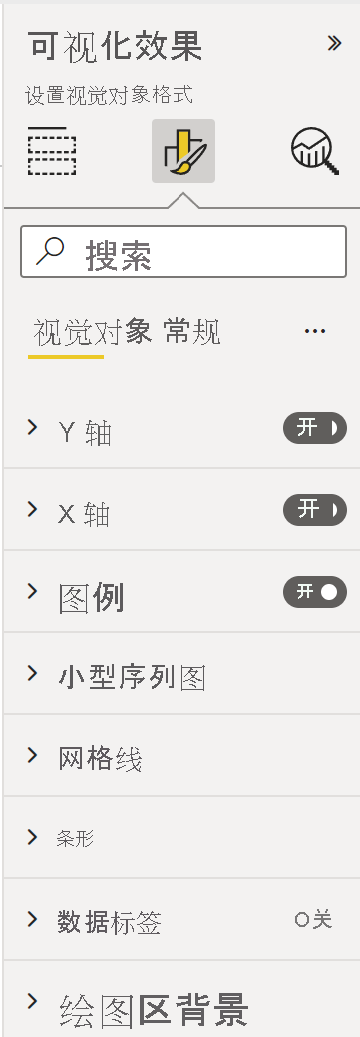
此示例将条形图上的 X 轴呈现为静态对象。
我们已将 enableAxis 属性添加到 capabilities 文件和 barChartSettings 接口。 将以下代码添加到 barChart.ts 文件中的 iVisual 类之前,以绘制 X 轴 :
TypeScript复制
function getAxisTextFillColor(
objects: DataViewObjects,
colorPalette: ISandboxExtendedColorPalette,
defaultColor: string): string { if (colorPalette.isHighContrast) { return colorPalette.foreground.value;
} return getValue(
objects, "enableAxis", "fill",
{
solid: {
color: defaultColor,
}
},
).solid.color;
}
(可选)添加颜色(数据绑定对象)
数据绑定对象类似于静态对象,但通常处理数据选择。 例如,可使用数据绑定对象以交互方式选择与每个数据点关联的颜色。

已在 capabilities 文件中定义了 colorSelector 对象。
每个数据点以一种不同颜色表示。 我们在 BarChartDataPoint 接口中包含了颜色,并在 IVisualHost 中定义每个数据点时为其分配了默认颜色。
TypeScript复制
function getColumnColorByIndex(
category: DataViewCategoryColumn,
index: number,
colorPalette: ISandboxExtendedColorPalette,): string { if (colorPalette.isHighContrast) { return colorPalette.background.value;
} const defaultColor: Fill = {
solid: {
color: colorPalette.getColor(`${category.values[index]}`).value,
}
}; return getCategoricalObjectValue(
category,
index, 'colorSelector', 'fill',
defaultColor
).solid.color;
}function getColumnStrokeColor(colorPalette: ISandboxExtendedColorPalette): string { return colorPalette.isHighContrast
? colorPalette.foreground.value
: null;
}function getColumnStrokeWidth(isHighContrast: boolean): number { return isHighContrast
? 2
: 0;
}
visualTransform 函数中的 colorPalette 服务管理这些颜色。 由于 visualTransform 会循环访问每个数据点,因此它是分配分类对象(如颜色)的理想位置。
有关如何向条形图添加颜色的更详细的说明,请转到向 Power BI 视觉对象添加颜色
备注
验证你的最终 barChart.ts 文件类似于此 barChart.ts 源代码,或者下载 barChart.ts 源代码并用它替换你的文件 。
对象枚举实用工具(可选)
对象属性值作为 dataView 中的元数据提供,但没有可帮助检索这些值的服务。 ObjectEnumerationUtility 是一组可选的静态函数,可循环访问 dataView 并检索对象值。 在 src 文件夹中创建名为 objectEnumerationUtility.ts 的文件,并将以下代码复制到其中:
TypeScript复制
/**
* Gets property value for a particular object.
*
* @function
* @param {DataViewObjects} objects - Map of defined objects.
* @param {string} objectName - Name of desired object.
* @param {string} propertyName - Name of desired property.
* @param {T} defaultValue - Default value of desired property.
*/export function getValueT>(objects: DataViewObjects, objectName: string, propertyName: string, defaultValue: T ): T { if(objects) { let object = objects[objectName]; if(object) { let property: T = object[propertyName]; if(property !== undefined) { return property;
}
}
} return defaultValue;
}/**
* Gets property value for a particular object in a category.
*
* @function
* @param {DataViewCategoryColumn} category - List of category objects.
* @param {number} index - Index of category object.
* @param {string} objectName - Name of desired object.
* @param {string} propertyName - Name of desired property.
* @param {T} defaultValue - Default value of desired property.
*/export function getCategoricalObjectValueT>(category: DataViewCategoryColumn, index: number, objectName: string, propertyName: string, defaultValue: T): T { let categoryObjects = category.objects; if (categoryObjects) { let categoryObject: DataViewObject = categoryObjects[index]; if (categoryObject) { let object = categoryObject[objectName]; if (object) { let property: T = object[propertyName]; if (property !== undefined) { return property;
}
}
}
} return defaultValue;
}
函数 getCategoricalObjectValue 提供一种通过属性的类别索引访问属性的简便方法。 你必须提供与 capabilities.json 中的对象和属性匹配的 objectName 和 propertyName。
请参阅 objectEnumerationUtility.ts,获取源代码。
测试视觉对象
在 Power BI Server 中运行视觉对象,查看其外观:
在 PowerShell 中,导航到项目的文件夹并启动开发应用。
PowerShell复制
pbiviz start托管在计算机上的视觉对象现在正在运行。
重要
在本教程结束之前,请不要关闭 PowerShell 窗口。 若要停止运行视觉对象,请输入 Ctrl+C,若系统提示终止批处理作业,请输入 Y,然后按 Enter 。
通过从“可视化效果”窗格中选择“开发人员视觉对象”,查看 Power BI 服务中的视觉对象 。
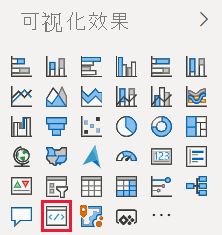
向视觉对象添加数据
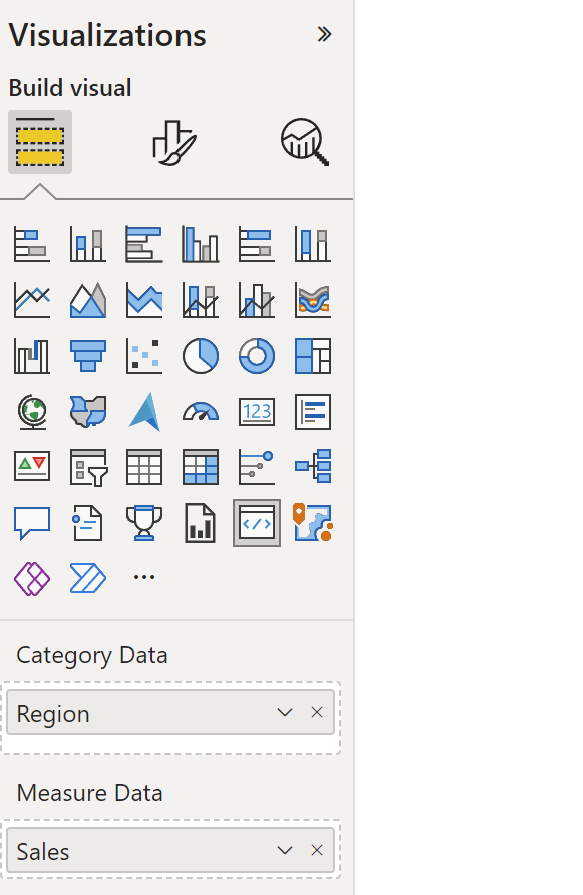
拖动视觉对象的边缘可更改大小,并注意规模的调整方式。
打开和关闭 X 轴。

更改不同类别的颜色。
添加其他功能
可通过添加更多功能来进一步自定义视觉对象。 可添加用于增加视觉对象的功能、增强其观感或让用户更好地控制其外观的功能。 例如,你能够:
添加选择并与其他视觉对象交互
添加属性窗格滑块以控制不透明度
添加对工具提示的支持
添加登陆页面
添加本地语言支持
打包视觉对象
将视觉对象加载到 Power BI Desktop 中或者在 Power BI 视觉对象库中与社区共享视觉对象之前,必须将视觉对象打包。
按照打包 Power BI 视觉对象中的说明,准备视觉对象以进行共享。
备注
有关包含更多功能(包括工具提示和上下文菜单)的条形图的完整源代码,请参阅 Power BI 视觉对象示例条形图。






 Tableau
Tableau






 Tableau
Tableau Minitab
Minitab




 Alteryx
Alteryx














 Neo4j
Neo4j











 Talend
Talend



















 IM
IM



 华为云
华为云 腾讯云
腾讯云 IT/安全
IT/安全







